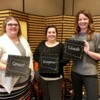Twenty-six individuals from multiple sectors across the state were selected to participate in a training and learning community around building self-healing communities. Participants spent two days with Dr. Robert Anda, Laura Porter, and Kathy Adams learning about the impacts of trauma, the ACE study, and how to support positive change within a community. The energy in the room was palpable.
Over the course of two days, not only did the group gain knowledge, but a community was formed. So many emotions filled the room… I recently read a quote that said “if it excites you and scares you at the same time, it probably means you should do it.” I took that as a sign that we were on the right path with the SD ACEs and Resiliency Fellowship! Because let me tell you … as we embark on this journey I am beyond excited… but also quite terrified!
Let me explain… it is easy to see why I am excited. Once you learn about the NEAR sciences and trauma informed care, it is impossible to see the world the same. You immediately begin looking at everything through a trauma informed lens… from your family, to your co-workers, to the woman in traffic, to those you serve. And you begin to realize that there isn’t an us and them. WE are all in this together. And ACEs and resiliency gives us a broad road map.
Like many of you, I have been doing this work long enough to see and hear how things just seem to be getting more difficult. Our clients have greater challenges, their needs are more complex, kids are engaging in riskier behaviors at younger ages, and sometimes it just feels overwhelming. At the same time, resources are decreasing. We feel we have more to do, and less to do it with. We see this in our co-workers, as they deal with the impacts of vicarious trauma. And we see it in our communities as they express feelings of hopelessness. We are living in a time where families are passing down their un-addressed trauma, and each generation starts with more ACEs than the last. Without a doubt, we need to do something different. We need to tap into resiliency. We need to build up resilient children. To do that we need to build up resilient parents. And to do that we need build the resiliency of our communities. Not a simple task, but powerful. Because as we build one, it automatically feeds into the next… creating a positive cycle of cultural change.
The NEAR science and self-healing community model excites me because it takes a holistic approach. We cannot continue to address issues one at a time, with a silo approach. Our communities, families, and children are dealing with issues that are far too complex and inter-related. The whack-a-mole approach to treatment or prevention is not efficient or effective. And worse it can exasperate the problem by pitting one issue against another, as funders, organizations, and community members try to decide which problem is worse!
So it is easy to see why I’m excited about this journey we are embarking on. But why am I scared? I am scared because the deeper I go into this paradigm shift, the more I know it is what we need. And I know that we, as the initial cohort, have a great responsibility in helping others to see this truth. And it will NOT be easy. The ideas behind this movement are both simple and extremely complex. The path to success requires both grassroots movement and top-down support. The results of this will be both immediate and greatly delayed. And as we carry all of these opposing truths with us, we cannot become discouraged. I kinda see it like a long-term weight loss plan… I can’t get discouraged when I get on the scale next week and there is no noticeable change. I can’t say it doesn’t matter that I worked out every day and didn’t eat the cake. Rather I need to keep my eye on the long-game. We need to stay focused on why we are doing this and have faith in the long-term effects. We must trust the communities that came before us and their results, we must celebrate the small successes to keep us motivated, and we must continue to dream big. Because when I’m asked what this is going to look like in three years, I confidently and proudly say I don’t know. And the reason I don’t know is that every person along this movement will take it farther then I myself can imagine. Each person will use what they learn to change their circles of influence in ways I hadn’t even thought of. Together we will build a more connected and resilient South Dakota.
After two intense and long days, fellows returned home with the tools they need to bring this back to their communities. We are excited to get this message out across our state. If you interact with humans, you need this training! Anyone interested in training on the NEAR sciences in South Dakota can contact Tanya Fritz at Children’s Home Society 605 343-2811 to schedule a training. South Dakota ACEs and Resiliency Fellows are ready to Educate, Empower, and Connect!



Comments (4)